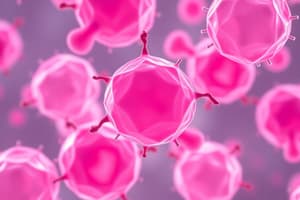Podcast
Questions and Answers
What condition is characterized by malignant proliferation of plasma cells leading to skeletal pain and renal failure?
What condition is characterized by malignant proliferation of plasma cells leading to skeletal pain and renal failure?
- Lymphadenopathy
- Multiple Myeloma (correct)
- Hypersplenism
- Splenomegaly
Which symptom is NOT typically associated with Multiple Myeloma?
Which symptom is NOT typically associated with Multiple Myeloma?
- Pancytopenia
- Spinal cord compression
- Hypercalcemia
- Hepatomegaly (correct)
Which of the following is a treatment option for hypersplenism?
Which of the following is a treatment option for hypersplenism?
- Chemotherapy
- Splenectomy (correct)
- Radiation therapy
- Bone marrow transplant
What does congestive splenomegaly indicate?
What does congestive splenomegaly indicate?
How is Multiple Myeloma primarily diagnosed?
How is Multiple Myeloma primarily diagnosed?
What platelet count is classified as thrombocytopenia?
What platelet count is classified as thrombocytopenia?
Which of the following is NOT a clinical manifestation of thrombocytopenia?
Which of the following is NOT a clinical manifestation of thrombocytopenia?
What is a likely cause of thrombocythemia?
What is a likely cause of thrombocythemia?
In patients with heparin-induced thrombocytopenia (HIT), the primary problem is caused by which mechanism?
In patients with heparin-induced thrombocytopenia (HIT), the primary problem is caused by which mechanism?
What happens to platelet counts after a splenectomy?
What happens to platelet counts after a splenectomy?
What is a common cause of impaired hemostasis?
What is a common cause of impaired hemostasis?
Which of the following is a characteristic of Disseminated Intravascular Coagulation (DIC)?
Which of the following is a characteristic of Disseminated Intravascular Coagulation (DIC)?
What underlying condition can exacerbate bleeding in a person with DIC?
What underlying condition can exacerbate bleeding in a person with DIC?
Which symptom is commonly associated with Idiopathic Thrombocytopenic Purpura (ITP)?
Which symptom is commonly associated with Idiopathic Thrombocytopenic Purpura (ITP)?
What is a potential etiology of Disseminated Intravascular Coagulation (DIC)?
What is a potential etiology of Disseminated Intravascular Coagulation (DIC)?
Which type of anemia is characterized by large stem cells in the bone marrow that result in unusually large red blood cells?
Which type of anemia is characterized by large stem cells in the bone marrow that result in unusually large red blood cells?
What is the primary cause of pernicious anemia?
What is the primary cause of pernicious anemia?
Which clinical manifestation is NOT commonly associated with anemia?
Which clinical manifestation is NOT commonly associated with anemia?
Which treatment option is specifically designed to suppress anti-platelet antibodies?
Which treatment option is specifically designed to suppress anti-platelet antibodies?
What term describes the shape of red blood cells that are smaller than normal in microcytic-hypochromic anemia?
What term describes the shape of red blood cells that are smaller than normal in microcytic-hypochromic anemia?
How does hypoxemia contribute to heart failure?
How does hypoxemia contribute to heart failure?
Which vitamin deficiency is primarily responsible for ineffective DNA synthesis in pernicious anemia?
Which vitamin deficiency is primarily responsible for ineffective DNA synthesis in pernicious anemia?
Which of the following factors is NOT commonly associated with reduced red blood cell production?
Which of the following factors is NOT commonly associated with reduced red blood cell production?
What is the most common type of anemia worldwide?
What is the most common type of anemia worldwide?
Which symptom is specifically associated with vitamin B12 deficiency in its late stages?
Which symptom is specifically associated with vitamin B12 deficiency in its late stages?
What characterizes microcytic-hypochromic anemias?
What characterizes microcytic-hypochromic anemias?
What is a common treatment for sideroblastic anemia?
What is a common treatment for sideroblastic anemia?
What condition results from the inability to generate mature blood cells?
What condition results from the inability to generate mature blood cells?
Which of the following is NOT a symptom of iron excess conditions like hereditary hemochromatosis?
Which of the following is NOT a symptom of iron excess conditions like hereditary hemochromatosis?
Which leukocyte condition is associated with a low white blood cell count?
Which leukocyte condition is associated with a low white blood cell count?
What is the primary etiology of Polycythemia Vera?
What is the primary etiology of Polycythemia Vera?
Study Notes
Multiple Myeloma
- Malignant proliferation of plasma cells, leading to bone marrow infiltration and tumor masses in the skeletal system
- S/S: Skeletal pain, progressing to osteoporosis, hypercalcemia, spinal cord compression, pancytopenia, and renal failure
- Diagnosis: Bone marrow biopsy, immunoglobulin levels (M protein), X-ray (bone erosion), and Bence Jones protein (urine test)
- Treatment: Chemotherapy, bone-protecting medications, radiation therapy, and pain management
Alterations of Splenic Function
- Functions: Phagocytosis of blood cells, antibody production, and blood storage
- Splenomegaly: Enlarged spleen, potential early indicator of underlying conditions; can be filled with blood, increasing rupture risk
- Congestive Splenomegaly: Associated with ascites, portal hypertension, and esophageal varices in cases of hepatic cirrhosis
- Hypersplenism: Overactive splenic functions
- Clinical Manifestations: Cytopenias and splenomegaly
- Treatment: Splenectomy (surgical removal of the spleen)
Alterations of Hematological Function: Thrombocytopenia
- Normal platelet count: 150-400 x 10^9/L
- Thrombocytopenia: Platelet count less than 150 x 10^9/L, usually asymptomatic until below 100; minor trauma can trigger abnormal bleeding
- Severe Thrombocytopenia (less than 20 x 10^9/L): Spontaneous major bleeding episodes
- Causes: Hypersplenism, autoimmune disease, hypothermia, viral/bacterial infections (DIC)
- Clinical Manifestations: Spontaneous petechiae, purpura, GI bleeding, GU bleeding, pulmonary mucosa bleeding, gum bleeding
- Treatment: Address the underlying cause and platelet transfusions
Heparin-Induced Thrombocytopenia (HIT)
- Adverse reaction to heparin (IV or LMWH), immune-mediated destruction of platelets by IgG antibodies
- Clinical Manifestations: Venous and arterial thrombosis, thrombocytopenia-related bleeding
- Lab Values: PTT (for heparin) and INR (for warfarin)
Thrombocythemia
- Excessive platelet production by the bone marrow
- Primary Thrombocythemia: Overproduction of megakaryocyte cells
- Secondary Thrombocythemia: Occurs after a splenectomy
- Characteristics: Platelet count >400 x 10^9/L
- Complications: Microvascular thrombosis or hemorrhage
Disorders of Coagulation: Impaired Hemostasis
- Defects or deficiencies in clotting factors
- Inherited: Hemophilias and von Willebrand's disease
- Acquired: Deficient clotting factor synthesis by the liver (liver disease, Vitamin K deficiency)
Consumptive Thrombohemorrhagic Disorders
- Hemorrhage and thrombosis occur simultaneously.
- Disseminated Intravascular Coagulation (DIC)
Disseminated Intravascular Coagulation (DIC)
- Complex disorder involving simultaneous clotting and hemorrhage.
- Pathogenesis: Vascular endothelium damage triggers clot formation, fibrin clots block blood flow, leading to organ failure (kidney and lungs), platelet depletion and bleeding. Imbalance between coagulation and fibrinolytic systems.
- Etiology: Sepsis, pregnancy complications, infections, trauma, liver disease, hypoxia
- S/S: Bleeding from venipuncture sites, arterial lines, purpura, petechiae, hematomas, symmetrical cyanosis, hypovolemic shock.
- Treatment: Address the underlying cause, control ongoing thrombosis, and maintain organ function
Thromboembolic Disorders
- Arterial or venous thrombi
- Virchow's Triad:
- Endothelial damage
- Abnormal blood flow
- Hypercoagulability
- Lab Value:
- D-dimer (for thrombin)
- Signs & Symptoms:
- Pain
- Swelling
- Redness
- Warmth
- Tenderness
Idiopathic Thrombocytopenic Purpura (ITP)
- Immunologic platelet destruction leading to thrombocytopenia
- Types: Acute (post-viral infection), chronic (immunological disorders)
- S/S: Thrombocytopenia-related bleeding
- Diagnostic Tests: Platelet count, bone marrow study
- Treatment: IVIg infusion to suppress anti-platelet antibodies
Erythrocyte Deficiencies: Anemia
- Reduced RBC count, hemoglobin quality/quantity in circulating blood
- Causes: Impaired RBC production (blood loss, increased RBC destruction, or a combination)
- Classification:
- -cytic: Cell size
- -chromic: Hemoglobin content
- Key Types: Macrocytic-Normochromic (Pernicious Anemia), Microcytic-Hypochromic Anemia, Sideroblastic Anemia, Normocytic-Normochromic Anemia
Clinical Manifestations & Treatment of Anemias
- Main Alteration: Reduced oxygen-carrying capacity, leading to tissue hypoxia
- Hypoxia Complications: Heart failure, respiratory symptoms, impaired wound healing
- Classic Symptoms: Fatigue, weakness, dyspnea, pallor.
- Treatment: Address underlying cause, relieve symptoms, blood transfusions, dietary correction, vitamin/iron supplements
Macrocytic-Normochromic Anemias
- Large RBCs due to ineffective DNA synthesis (vitamin B12 deficiency)
- Premature RBC Death (Eryptrosis): Release of bilirubin, leading to jaundice
Pernicious Anemia
- Lack of intrinsic factor (gastric) for vitamin B12 absorption, due to autoimmune gastritis or previous H. pylori infection
- Early Symptoms: Nonspecific and vague
- Late Symptoms (hemoglobin 70-80 g/L): Weakness, fatigue, paresthesia, loss of appetite, abdominal pain, weight loss, sore tongue, jaundice, right heart failure symptoms
- Treatment: High oral doses of vitamin B12, lifelong treatment
Microcytic-Hypochromic Anemias
- Small, pale RBCs with reduced hemoglobin
- Disorders of Iron Metabolism
- Decreased Oxygen-Carrying Capacity
Iron Deficiency Anemia
- Most common anemia
- S/S: Fatigue, weakness, shortness of breath, pale palms and conjunctiva
Sideroblastic Anemia
- Insufficient iron uptake, abnormal hemoglobin synthesis
- S/S: Similar to iron deficiency anemia
Treatment
- Increase dietary iron intake, IV iron infusions
Normocytic-Normochromic Anemias
- Normal size and hemoglobin content, insufficient RBC count
- Aplastic Anemia: Inability to produce mature blood cells
- Insufficient Erythropoiesis: Often autoimmune in nature
- Clinical Manifestations: Hypoxemia, pallor, weakness, fever, GI bleeding, purpura.
Erythrocyte Excess: Polycythemia
- Relative Polycythemia: Due to an underlying condition
- Absolute Polycythemia (Polycythemia Vera)
Polycythemia Vera
- Abnormal proliferation of bone marrow stem cells
- Increased Coagulability: Increased risk of blood clots
- Etiology: Unknown
Iron Excess
- Hereditary Hemochromatosis: Autosomal recessive disorder of iron metabolism, leading to iron overload
- Complications: Iron toxicity, tissue and organ damage (skin, heart, liver, pancreas, pituitary gland, joints)
- S/S: Fatigue, malaise, abdominal pain, hepatomegaly, abnormal liver enzymes, cardiomegaly
- Treatment: Dietary management (reduced red meat intake)
Alterations of Leukocyte Function
- Leukocytosis: High WBC count, often associated with infection
- Leukopenia: Low WBC count, increased susceptibility to infections
- -philia: Increased
- -penia: Reduced
Studying That Suits You
Use AI to generate personalized quizzes and flashcards to suit your learning preferences.
Related Documents
Description
Explore the critical aspects of Multiple Myeloma, including its symptoms, diagnosis, and treatment options. Additionally, learn about the functions and alterations of the spleen, such as splenomegaly and hypersplenism. This quiz provides insights into hematologic and splenic disorders.




